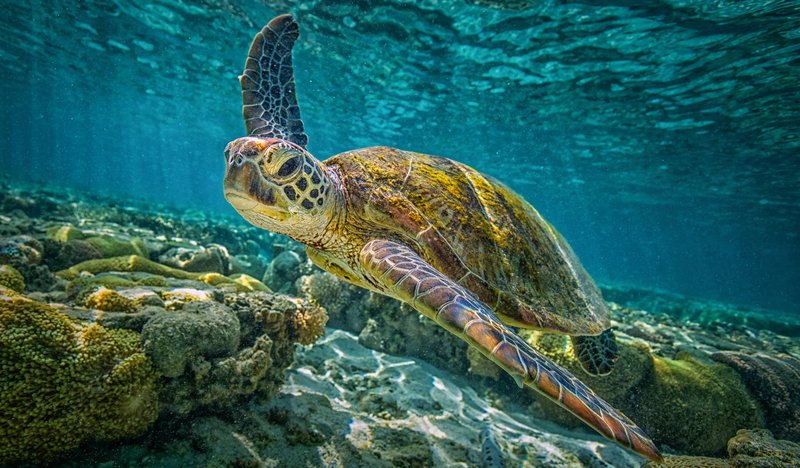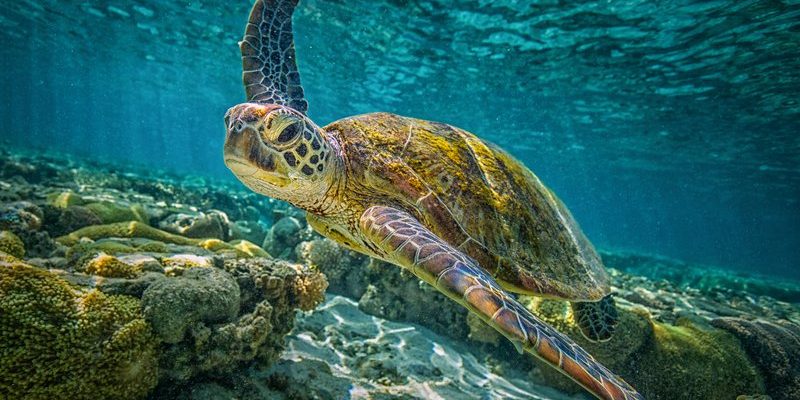
Loggerhead turtles, with their distinctive large heads and strong jaws, help maintain the delicate balance of marine environments. They feast on jellyfish and other soft-bodied creatures, which keeps their populations in check. Without these turtles, jellyfish might swarm the oceans, disrupting the food chain and impacting everything from fish to coral reefs. So, how exactly do loggerhead turtles fit into the bigger picture of ocean life? Let’s dive deeper!
What Are Loggerhead Turtles?
Loggerhead turtles are large, oceanic creatures that can weigh anywhere from 200 to 400 pounds. Their name comes from their big heads, which house powerful jaws designed for crushing hard-shelled prey like conchs and sea urchins. These turtles are primarily found in warm ocean waters around the world, from the Atlantic to the Mediterranean seas.
Loggerheads are known for their long migrations. They travel thousands of miles between feeding and nesting grounds, showcasing their incredible navigation skills. Wouldn’t it be something to travel that far just to find a perfect spot to lay eggs? After nesting, females return to the ocean, leaving their eggs to hatch and restart the cycle.
Unfortunately, loggerhead turtles face threats from habitat loss, pollution, and climate change. Understanding their role in marine ecosystems is vital for conservation efforts. Protecting these magnificent turtles not only benefits them but also helps safeguard entire ocean ecosystems.
The Role of Loggerhead Turtles in Food Webs
At the core of marine ecosystems is the food web, a complex system of energy flow between different species. Loggerhead turtles play a crucial role in this web. As omnivores, they have a diverse diet that includes jellyfish, crustaceans, and seaweed. This diet helps control the populations of their prey, which in turn affects other marine life.
For instance, by eating jellyfish, loggerheads prevent these creatures from overpopulating. An unchecked jellyfish population can lead to decreased populations of fish that rely on plankton for food. You might be wondering how such a big impact comes from one species—well, it’s all about the balance! When one part of the food web thrives or struggles, it resonates throughout the entire ecosystem.
Loggerhead turtles also serve as prey for larger marine animals. Sharks and orcas sometimes hunt them, connecting them to other levels in the food chain. Thus, loggerheads are essential for maintaining balance not just by their feeding habits but also by being part of the diet for other species.
Loggerhead Turtles and Seagrass Ecosystems
Seagrass beds are like underwater gardens, providing habitat and food for various marine species, including fish and invertebrates. Loggerhead turtles help maintain these ecosystems in more ways than one. For example, when they consume seagrass, it promotes new growth, allowing the seagrass to flourish. This regrowth creates a healthier environment for fish and other marine life.
Moreover, loggerheads’ nesting behavior contributes to the health of coastal ecosystems. When they nest on beaches, the eggs buried in the sand help to maintain the structural integrity of those areas. Healthy beaches lead to healthier seagrass beds, which then support more fish and wildlife.
It’s fascinating to think about how all these aspects of nature connect. Loggerheads are the unsung heroes, working quietly beneath the waves to keep the balance of their ocean homes.
The Impact of Loggerhead Turtles on Coral Reefs
Coral reefs are some of the most diverse ecosystems on the planet, often called the “rainforests of the sea.” Loggerhead turtles influence these delicate environments significantly. They help keep the populations of prey species, like sponges and algae, in check, preventing overgrowth that can smother corals.
By grazing on algae, loggerheads ensure that corals have the space they need to thrive. When corals are healthy, they provide shelter and food for countless marine organisms. You might not think about it often, but when loggerheads munch on algae, they’re not just snacking; they’re helping sustain a whole underwater community.
In addition to keeping algae in check, loggerhead turtles also contribute nutrients to the water through their waste. This nutrient cycling is vital for the growth of corals and the overall health of the reef system. It’s like a natural fertilizer, boosting the ecosystem without any human intervention!
Threats to Loggerhead Turtles and Their Ecosystems
Despite their important role, loggerhead turtles face many threats. Bycatch in fishing nets, climate change, and pollution significantly impact their populations. When loggerheads are accidentally caught, it can lead to injury or death, affecting their ability to contribute to marine ecosystems.
Climate change is another pressing issue. Warmer ocean temperatures can lead to coral bleaching, affecting the food and shelter available for loggerheads and other marine life. Additionally, rising sea levels and increased storm intensity impact nesting beaches, hindering reproduction.
Pollution, like plastic waste, poses a severe threat to loggerhead turtles. These turtles often mistake plastic bags for jellyfish, which leads to ingestion and serious health issues. Conserving their habitats and ensuring cleaner oceans are crucial steps toward protecting these turtles and the ecosystems they support.
Conservation Efforts for Loggerhead Turtles
Fortunately, many organizations and initiatives aim to protect loggerhead turtles and their habitats. Conservation efforts often focus on preserving nesting sites, reducing bycatch, and promoting awareness of the threats these turtles face. Nesting beaches are monitored and protected to ensure that female loggerheads can lay their eggs safely.
Furthermore, there are programs to help fishermen use turtle-friendly gear, minimizing bycatch. These efforts not only help loggerheads but also protect other marine species. Conservation organizations work tirelessly to educate the public about the importance of loggerhead turtles and their role in marine ecosystems.
You can get involved too! Simple actions like reducing plastic use, participating in beach clean-ups, or supporting turtle conservation programs can make a real difference. Every little effort counts!
Why Loggerhead Turtles Matter
So, why should we care about loggerhead turtles? Beyond their fascinating biology and amazing migrations, these turtles are indicators of ocean health. Their presence signifies a balanced and thriving marine ecosystem. When loggerhead populations decline, it can be a warning sign that something is wrong in the ocean.
By protecting loggerhead turtles, we’re also safeguarding countless other marine species and the overall health of our oceans. It’s a ripple effect you can feel across the globe. Each time we take steps to conserve these incredible turtles, we contribute to the health of our planet.
Let’s remember that loggerhead turtles are more than just turtles. They’re essential pieces of the ocean puzzle, and their survival is intertwined with ours.
In conclusion, loggerhead turtles play a vital role in marine ecosystems. From maintaining food webs to nurturing seagrass and coral reef health, their contributions are invaluable. By understanding and supporting their conservation, we can help ensure that future generations can marvel at these magnificent creatures gliding through the ocean. Let’s do our part to protect them and the vibrant marine life they support!

